Autonomous Driving Control for Passing Unsignalized Intersections Using the Semantic Segmentation Technique
Abstract
1. Introduction
2. Preliminaries
2.1. Modular Pipeline
2.2. Reinforcement Learning
2.3. Q Learning
2.4. DQN
2.5. Policy Gradient
2.6. Actor–Critic
2.7. DDPG
2.8. RDPG
2.9. CARLA Simulator
2.10. Driving Scenes
3. Our DRL Models
3.1. The Reward Mechanism
3.2. System Architecture
3.3. Training Process
- 1.
- First, the simulation environment is initialized. Multiple reference vehicles are generated at specified locations, and a training vehicle is placed at the starting point. A reference vehicle autonomously selects a path to enter the intersection, while the training vehicle must travel a short initial section to achieve a speed of over 20 km per hour. This is to prevent a low speed from triggering the environment’s reset mechanism.
- 2.
- After obtaining the current environmental state (), it is input into the two Actor networks of DDPG and RDPG. The Actor networks then generate an action output () based on the input state, including throttle, brake and steering control values. These actions are applied to the simulation environment, leading to the acquisition of the next state () and the cumulative reward (). The collection of experiences is stored in the Replay Buffer accordingly.
- 3.
- Once the Replay Buffer stores a set amount of training data, a batch of N experiences is selected and fed into the training model for the update of the Actor and Critic networks.
- 4.
- To maintain the correct operation of the training vehicle, reset conditions are established. These include detecting unstable acceleration and deceleration behaviors of the vehicle, sensing collisions with other objects and whether the vehicle reaches the final goal. If any of these conditions are met, the training environment is reset and corresponding penalties are applied. In contrast, if the conditions are normal, the vehicle’s driving actions continue to be controlled by the Online Actor network.
4. Experimental Results and Discussion
4.1. Training Environment
4.2. Hyperparameter Configuration
4.3. Training Results
4.4. Discussion
5. Conclusions
Author Contributions
Funding
Data Availability Statement
Conflicts of Interest
References
- Yurtsever, E.; Lambert, J.; Carballo, A.; Takeda, K. A survey of autonomous driving: Common practices and emerging technologies. IEEE Access 2020, 8, 58 443–58 469. [Google Scholar] [CrossRef]
- Road Traffic Safety Site. Available online: https://168.motc.gov.tw/ (accessed on 17 December 2023).
- Bertozzi, M.; Broggi, A.; Cellario, M.; Fascioli, A.; Lombardi, P.; Porta, M. Artificial vision in road vehicles. Proc. IEEE 2002, 90, 1258–1271. [Google Scholar] [CrossRef]
- Talebpour, A.; Mahmassani, H.S. Influence of connected and autonomous vehicles on traffic flow stability and throughput. Transp. Res. Part C Emerg. Technol. 2016, 71, 143–163. [Google Scholar] [CrossRef]
- Paden, B.; Čáp, M.; Yong, S.Z.; Yershov, D.; Frazzoli, E. A survey of motion planning and control techniques for self-driving urban vehicles. IEEE Trans. Intell. Veh. 2016, 1, 33–55. [Google Scholar] [CrossRef]
- Schwarting, W.; Alonso-Mora, J.; Rus, D. Planning and decision-making for autonomous vehicles. Annu. Rev. Control Robot. Auton. Syst. 2018, 1, 187–210. [Google Scholar] [CrossRef]
- Claussmann, L.; Revilloud, M.; Gruyer, D.; Glaser, S. A review of motion planning for highway autonomous driving. IEEE Trans. Intell. Transp. Syst. 2020, 21, 1826–1848. [Google Scholar] [CrossRef]
- Iftikhar, S.; Zhang, Z.; Asim, M.; Muthanna, A. Deep learning-based pedestrian detection in autonomous vehicles: Substantial issues and challenges. Electronics 2022, 11, 3551. [Google Scholar] [CrossRef]
- Chen, C.; Seff, A.; Kornhauser, A.; Xiao, J. DeepDriving: Learning affordance for direct perception in autonomous driving. In Proceedings of the IEEE International Conference on Computer Vision, Santiago, Chile, 7–13 December 2015; pp. 2722–2730. [Google Scholar]
- Iandola, F.; Moskewicz, M.; Karayev, S.; Girshick, R.; Darrell, T.; Keutzer, K. DenseNet: Implementing efficient ConvNet descriptor pyramids. arXiv 2014, arXiv:1404.1869. [Google Scholar]
- Espié, E. Torcs: The Open Racing Car Simulator. 2000. Available online: https://api.semanticscholar.org/CorpusID:16920486 (accessed on 25 May 2023).
- Sauer, A.; Savinov, N.; Geiger, A. Conditional affordance learning for driving in urban environments. arXiv 2018, arXiv:1806.06498. [Google Scholar]
- Szegedy, C.; Liu, W.; Jia, Y.; Sermanet, P.; Reed, S.; Anguelov, D.; Erhan, D.; Vanhoucke, V.; Rabinovich, A. Going deeper with convolutions. In Proceedings of the IEEE Conference on Computer Vision and Pattern Recognition, Boston, MA, USA, 7–12 June 2015; pp. 1–9. [Google Scholar]
- Chang, C.-C.; Tsai, J.; Lin, J.-H.; Ooi, Y.-M. Autonomous driving control using the DDPG and RDPG algorithms. Appl. Sci. 2021, 11, 10659. [Google Scholar] [CrossRef]
- Wolf, P.; Hubschneider, C.; Weber, M.; Bauer, A.; Härtl, J.; Dürr, F.; Zöllner, J.M. Learning how to drive in a real world simulation with deep Q-Networks. In Proceedings of the 2017 IEEE Intelligent Vehicles Symposium (IV), Los Angeles, CA, USA, 11–14 June 2017; pp. 244–250. [Google Scholar]
- Kendall, A.; Hawke, J.; Janz, D.; Mazur, P.; Reda, D.; Allen, J.M.; Lam, V.D.; Bewley, A.; Shah, A. Learning to drive in a day. In Proceedings of the 2019 International Conference on Robotics and Automation (ICRA), Montreal, QC, Canada, 20–24 May 2019; pp. 8248–8254. [Google Scholar]
- Agarwal, T.; Arora, H.; Schneider, J. Learning urban driving policies using deep reinforcement learning. In Proceedings of the 2021 IEEE International Intelligent Transportation Systems Conference (ITSC), Indianapolis, IN, USA, 19–22 September 2021; pp. 607–614. [Google Scholar]
- Dosovitskiy, A.; Ros, G.; Codevilla, F.; Lopez, A.; Koltun, V. CARLA: An open urban driving simulator. In Proceedings of the Conference on Robot Learning, California, MV, USA, 13–15 November 2017. [Google Scholar]
- Shah, S.; Dey, D.; Lovett, C.; Kapoor, A. Airsim: High-fidelity visual and physical simulation for autonomous vehicles. In Field and Service Robotics: Results of the 11th International Conference; Springer: Berlin/Heidelberg, Germany, 2018; pp. 621–635. [Google Scholar]
- AWS Deep Racer. Available online: https://aws.amazon.com/jp/deepracer/ (accessed on 17 December 2023).
- Liu, S.; Jia, J.; Fidler, S.; Urtasun, R. SGN: Sequential grouping networks for instance segmentation. In Proceedings of the IEEE International Conference on Computer Vision (ICCV), Venice, Italy, 22–29 October 2017; pp. 3496–3504. [Google Scholar]
- Wojke, N.; Bewley, A.; Paulus, D. Simple online and realtime tracking with a deep association metric. In Proceedings of the 2017 IEEE International Conference on Image Processing (ICIP), Beijing, China, 17 September 2017; pp. 3645–3649. [Google Scholar]
- Redmon, J.; Farhadi, A. YOLO9000: Better faster stronger. In Proceedings of the IEEE Conference on Computer Vision and Pattern Recognition (CVPR), Honolulu, HI, USA, 21–26 July 2017; pp. 7263–7271. [Google Scholar]
- Zhu, Z.; Liang, D.; Zhang, S.; Huang, X.; Li, B.; Hu, S. Traffic-sign detection and classification in the wild. In Proceedings of the IEEE Conference on Computer Vision and Pattern Recognition, Las Vegas, NV, USA, 27–30 June 2016; pp. 2110–2118. [Google Scholar]
- Wiering, M.; Otterlo, M. Reinforcement Learning: State-of-the-Art; Springer: Berlin, Germany, 2012. [Google Scholar]
- Watkins, C.J.; Dayan, P. Technical note: Q-learning. Mach. Learn. 1992, 8, 279–292. [Google Scholar] [CrossRef]
- Mnih, V.; Kavukcuoglu, K.; Silver, D.; Rusu, A.A.; Veness, J.; Bellemare, M.G. Human-level control through deep reinforcement learning. Nature 2015, 518, 529–533. [Google Scholar] [CrossRef] [PubMed]
- Paternain, S.; Bazerque, J.A.; Small, A.; Ribeiro, A. Stochastic policy gradient ascent in reproducing kernel hilbert spaces. IEEE Trans. Autom. Control 2021, 66, 3429–3444. [Google Scholar] [CrossRef]
- Silver, D.; Lever, G.; Heess, N.; Degris, T.; Wierstra, D.; Riedmiller, M. Deterministic policy gradient algorithms. In Proceedings of the 31st International Conference on Machine Learning (ICML-14), Beijing, China, 22–24 June 2014; pp. 387–395. [Google Scholar]
- Bhatnagar, S.; Sutton, R.S.; Ghavamzadeh, M.; Lee, M. Natural actor critic algorithms. Automatica 2009, 45, 2471–2482. [Google Scholar] [CrossRef]
- Jesus, J.C.; Bottega, J.A.; Bottega, J.A.; Cuadros, M.A.S.L.; Gamarra, D.F.T. Deep deterministic policy gradient for navigation of mobile robots in simulated environments. In Proceedings of the 2019 19th International Conference on Advanced Robotics (ICAR), Belo Horizonte, Brazil, 2–6 December 2019; pp. 362–367. [Google Scholar]
- Li, X.; Liu, H.; Wang, X. Solve he inverted pendulum problem base on DQN algorithm. In Proceedings of the 2019 Chinese Control and Decision Conference (CCDC), Nanchang, China, 3–5 June 2019; pp. 5115–5120. [Google Scholar]
- Heess, N.; Hunt, J.; Lillicrap, T.; Silver, D. Memory-based control with recurrent neural networks. arXiv 2015, arXiv:1512.04455. [Google Scholar]
- Hochreiter, S.; Schmidhuber, J. Long short-term memory. Neural Comput. 1997, 9, 1735–1780. [Google Scholar] [CrossRef] [PubMed]
- Tsai, J.; Chang, C.-C.; Li, T. Autonomous driving control based on the technique of semantic segmentation. Sensors 2023, 23, 895. [Google Scholar] [CrossRef] [PubMed]
- Tsai, J.; Chang, Y.-T.; Chuang, P.-H.; You, Z. An autonomous vehicle-following technique for self-driving cars based on the semantic segmentation technique. In Proceedings of the 16th IEEE International Symposium on Robotic and Sensors Environments, Yokohama, Japan, 16–19 November 2023. [Google Scholar]
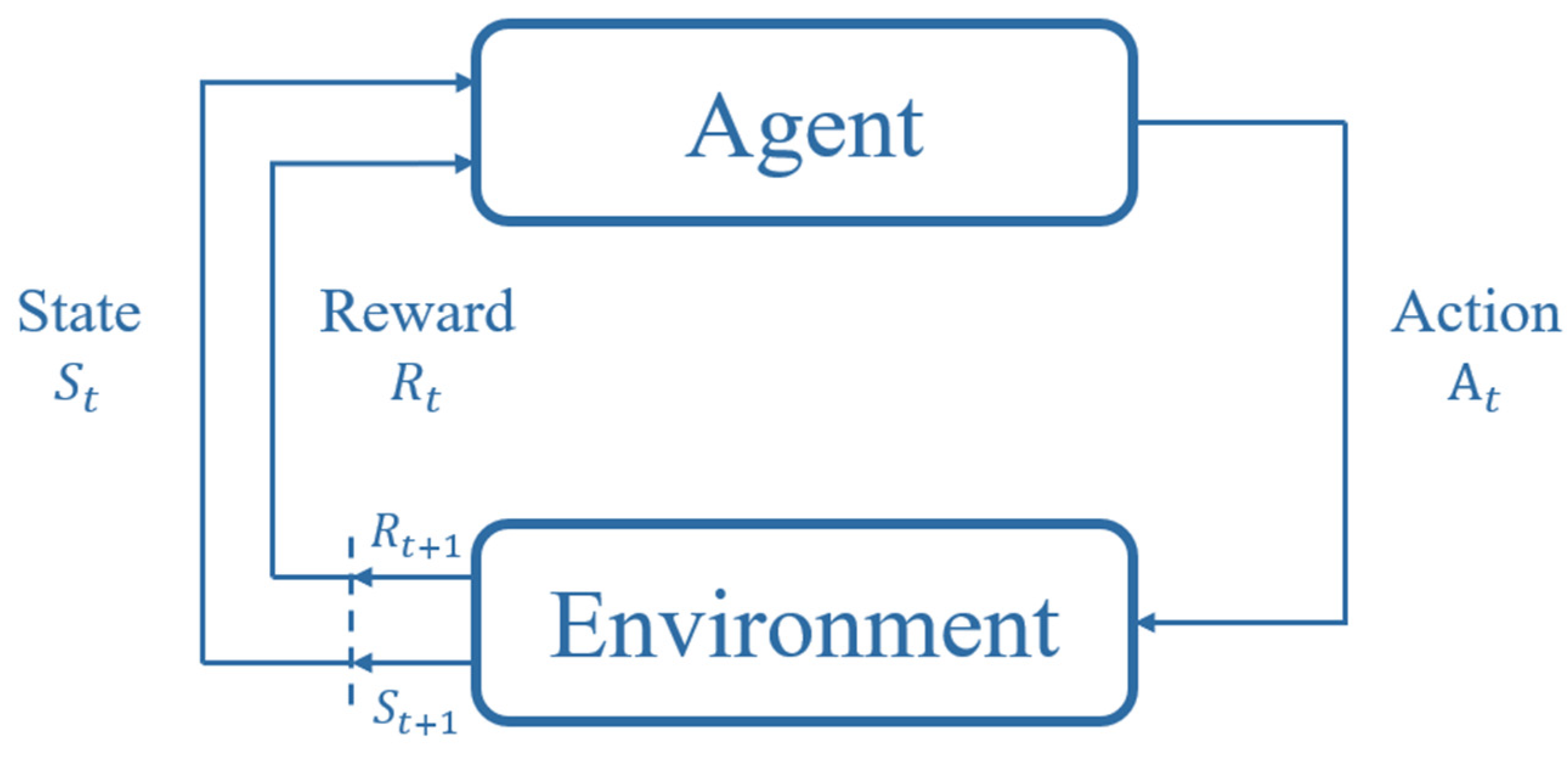
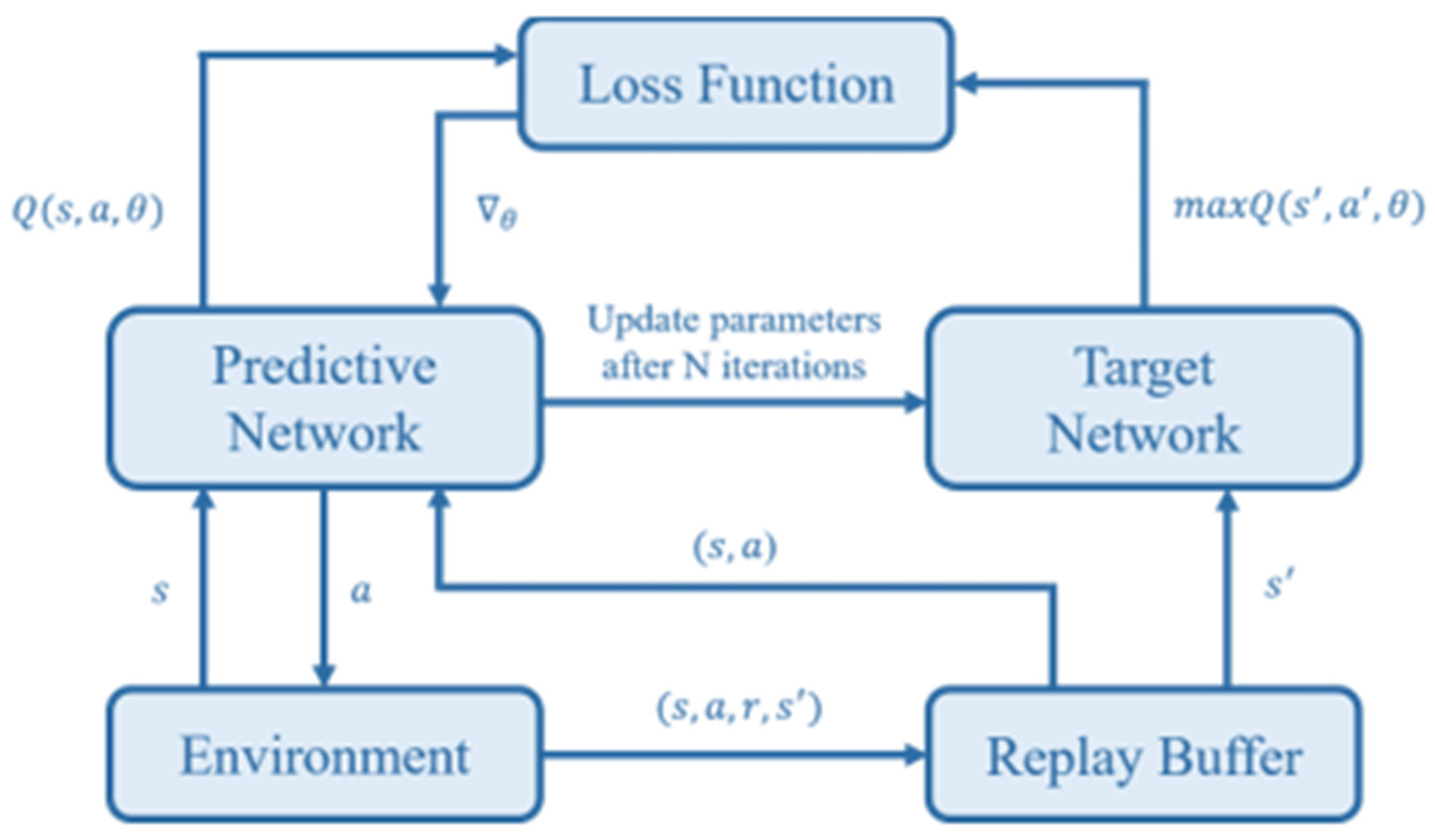
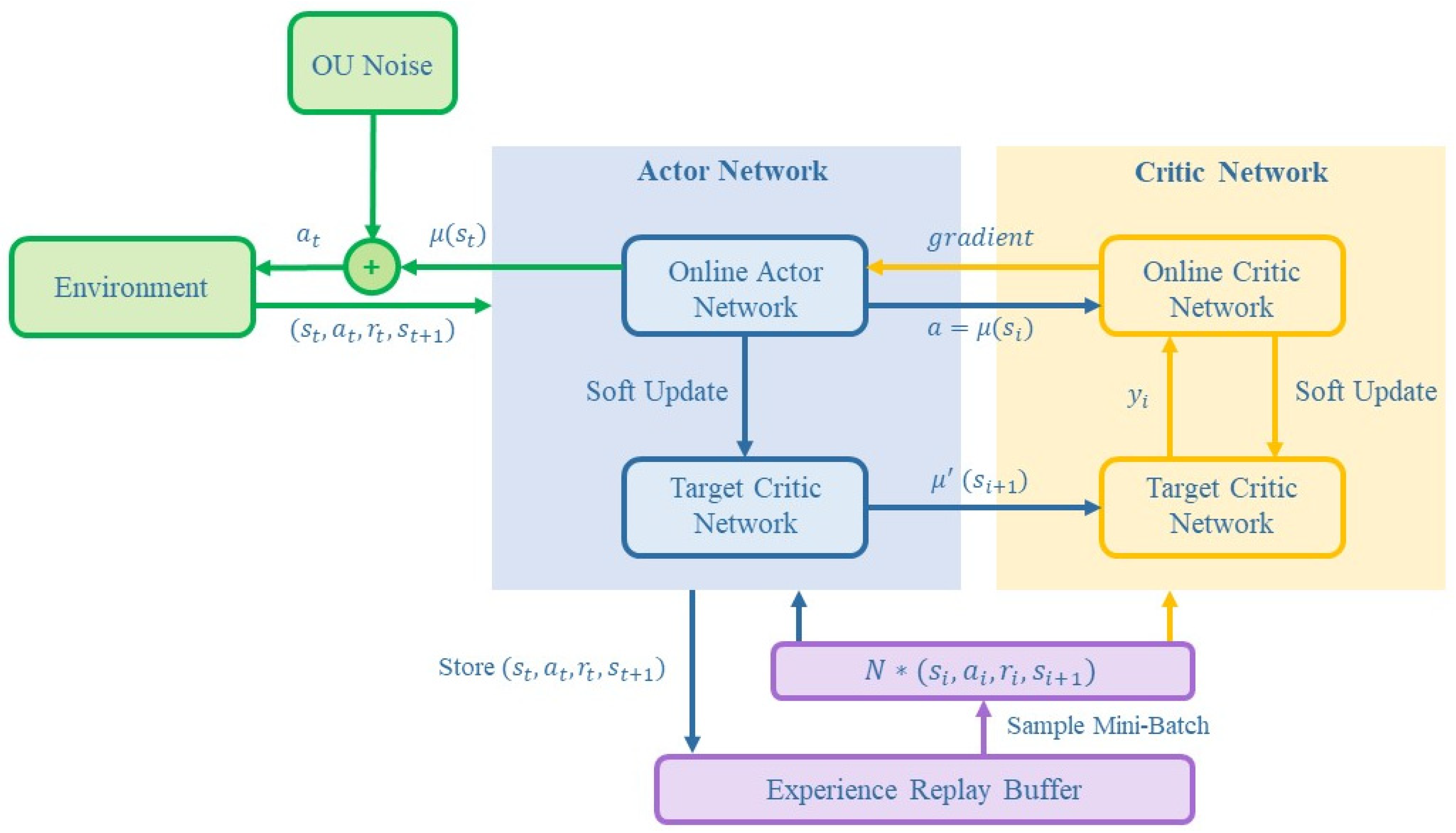
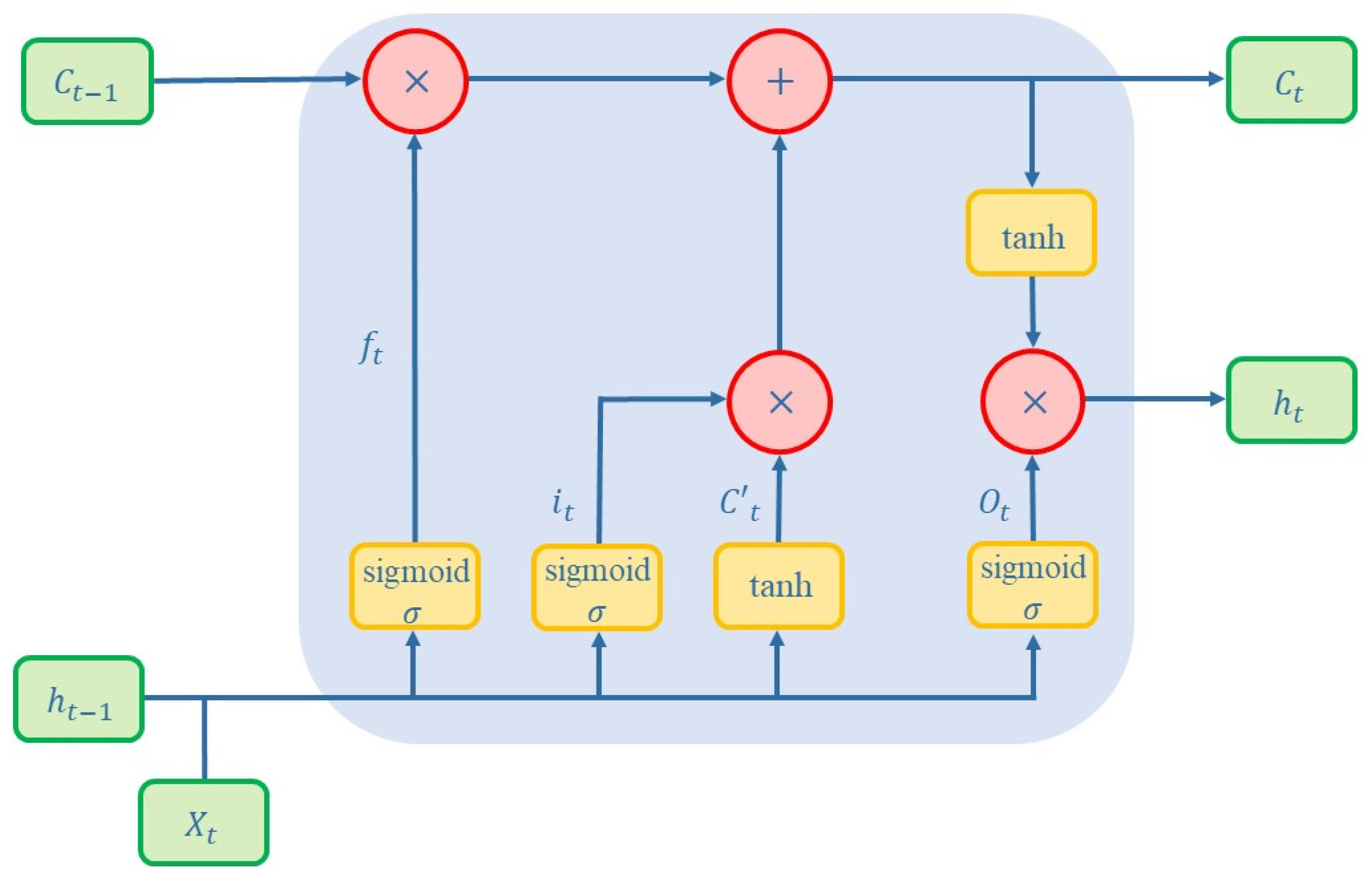
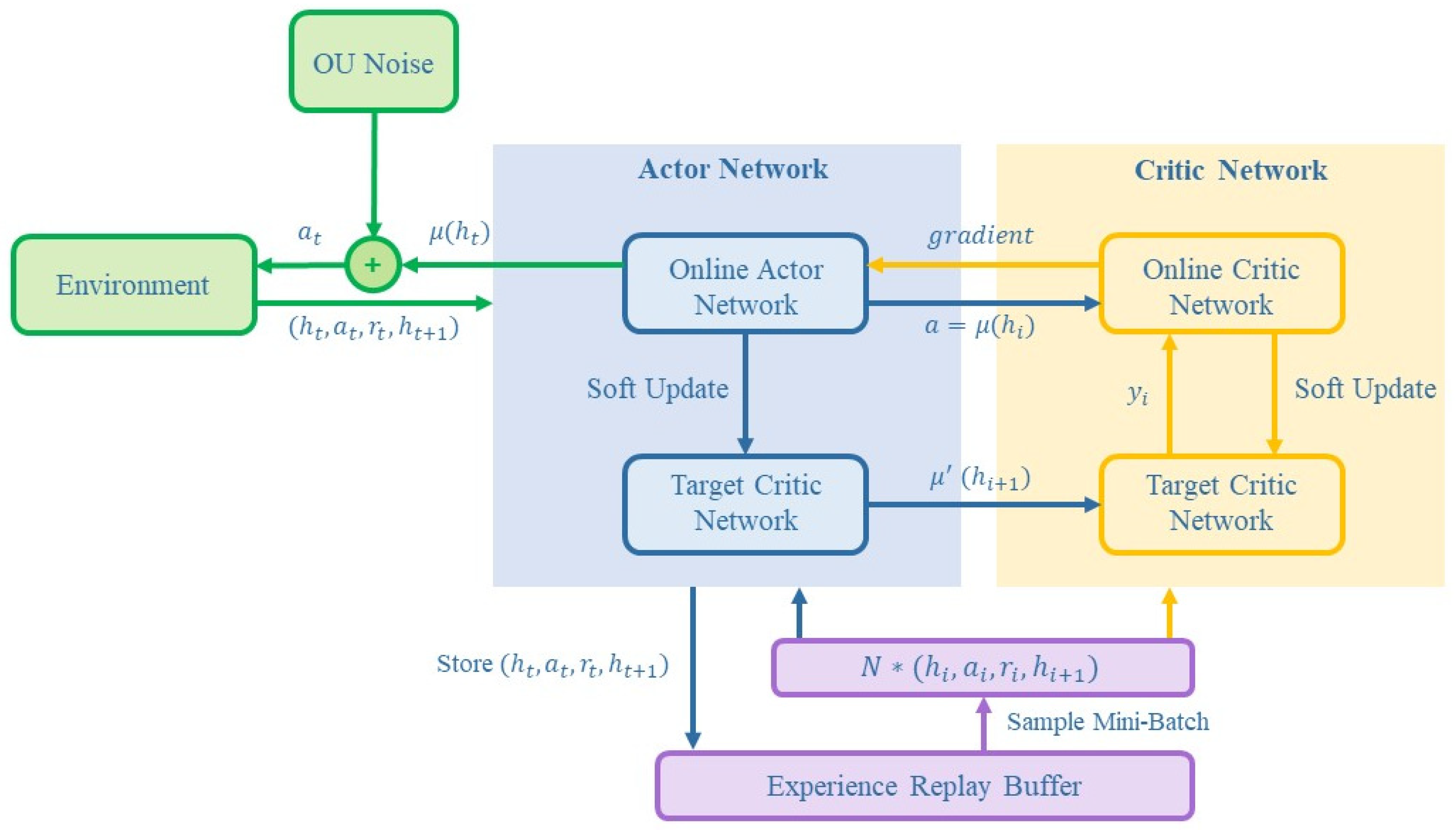
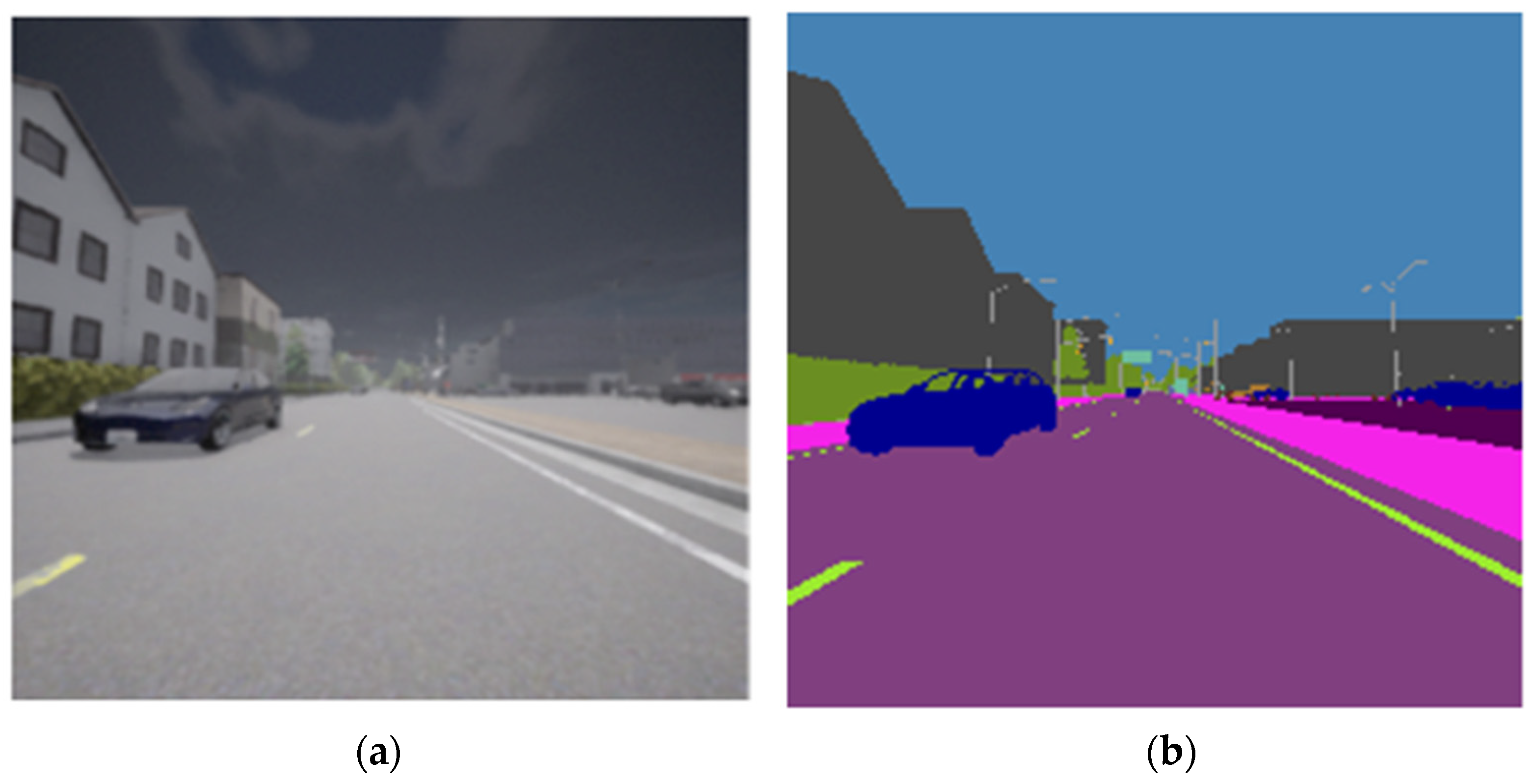
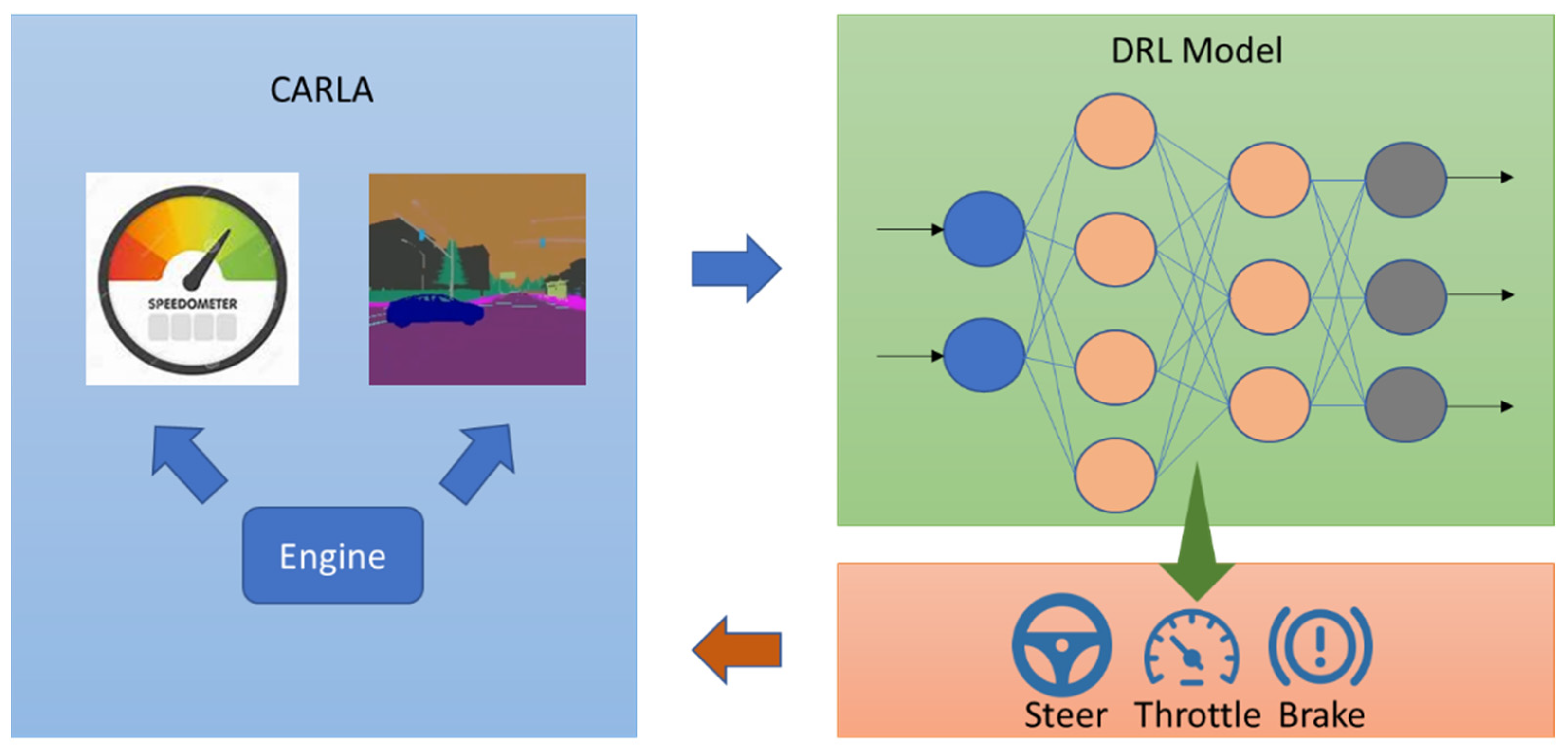



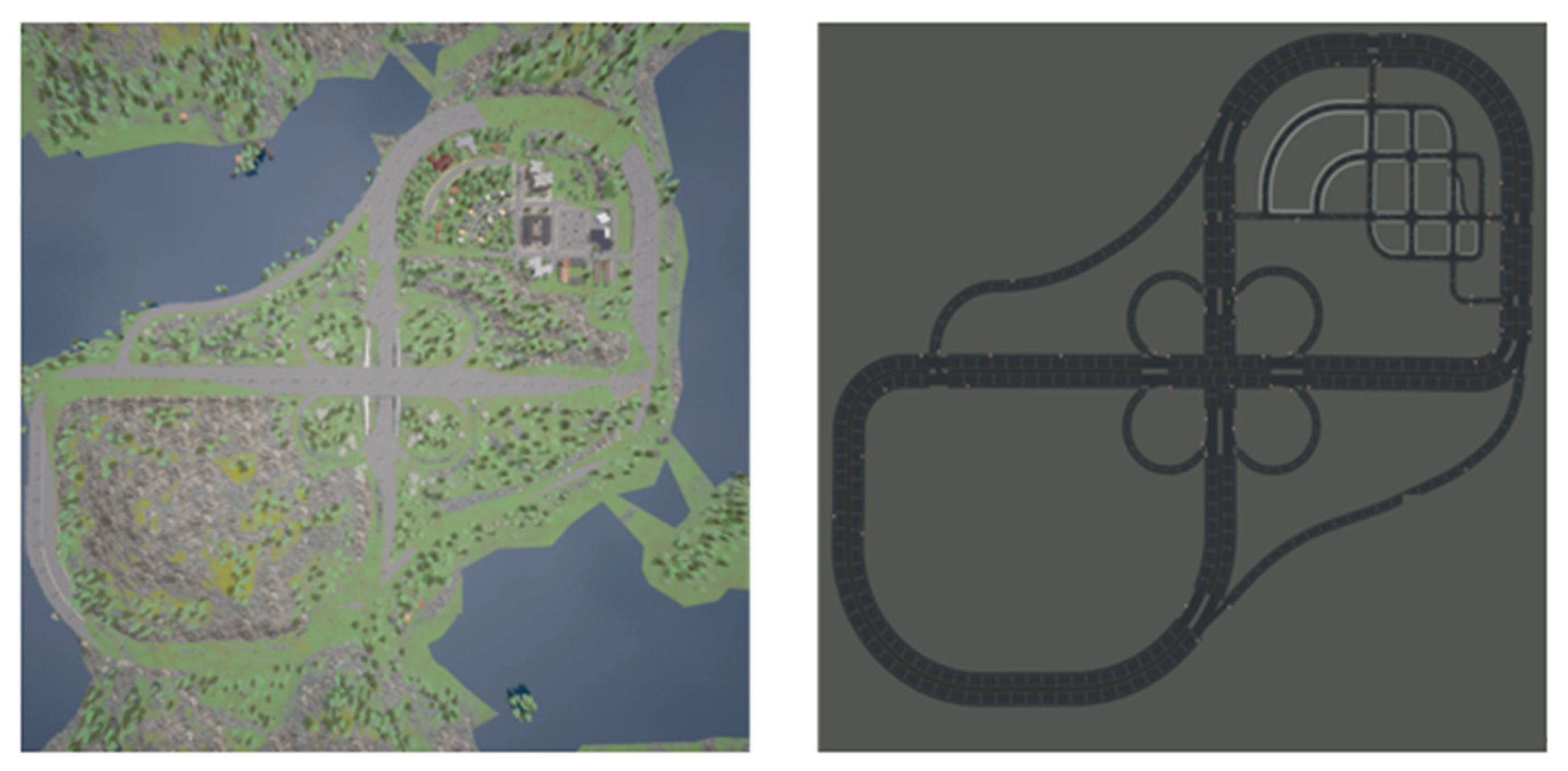
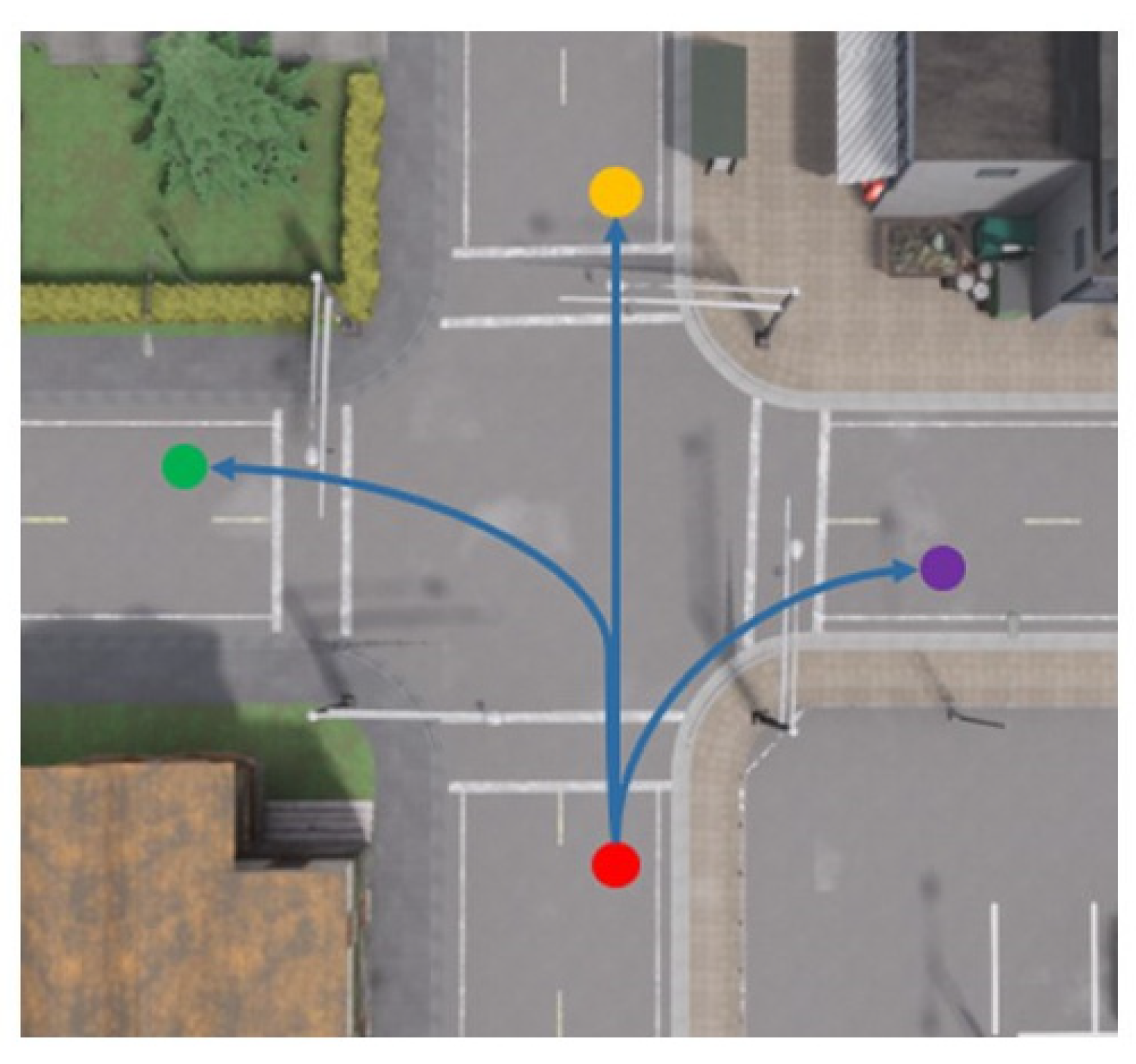
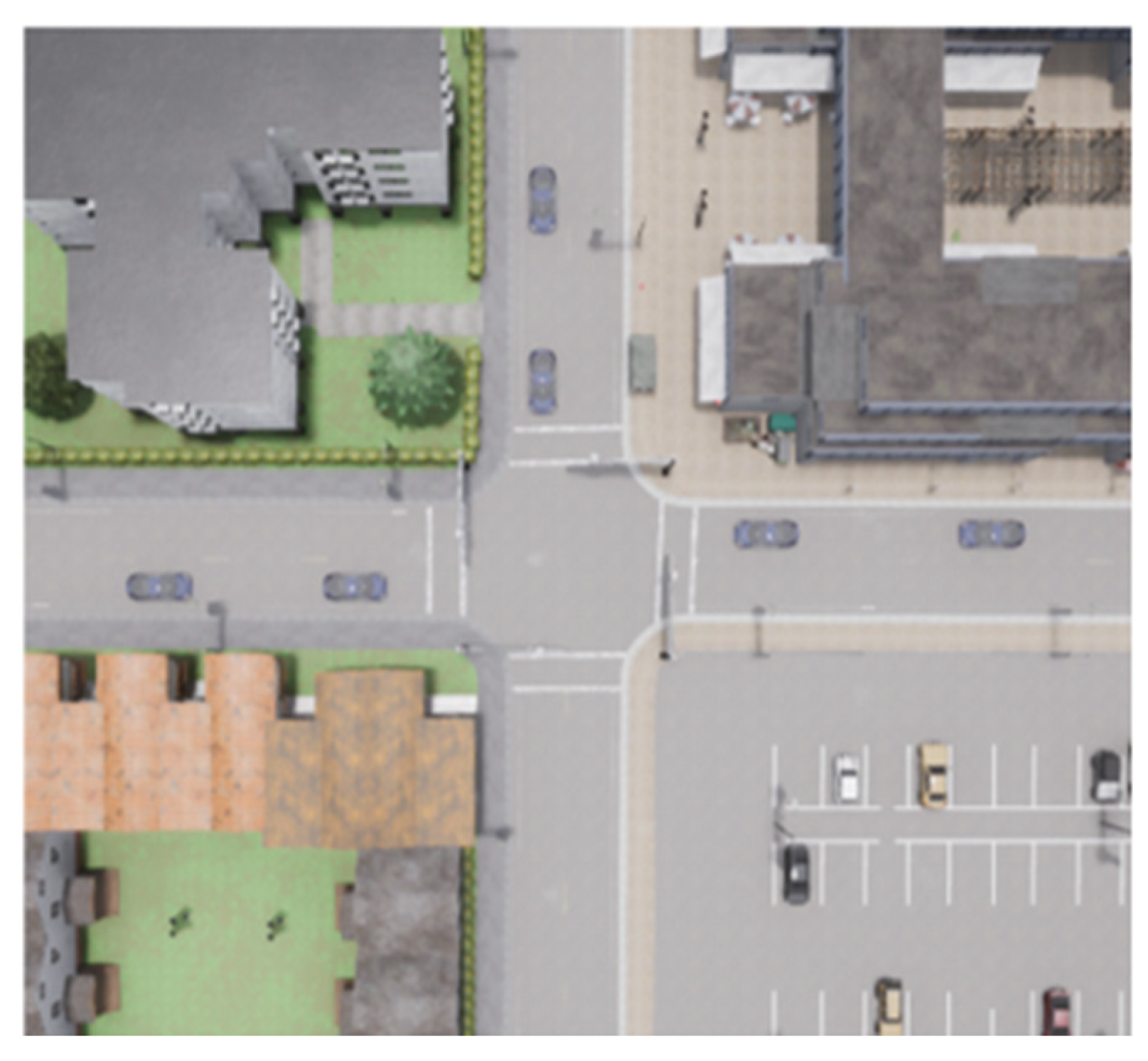
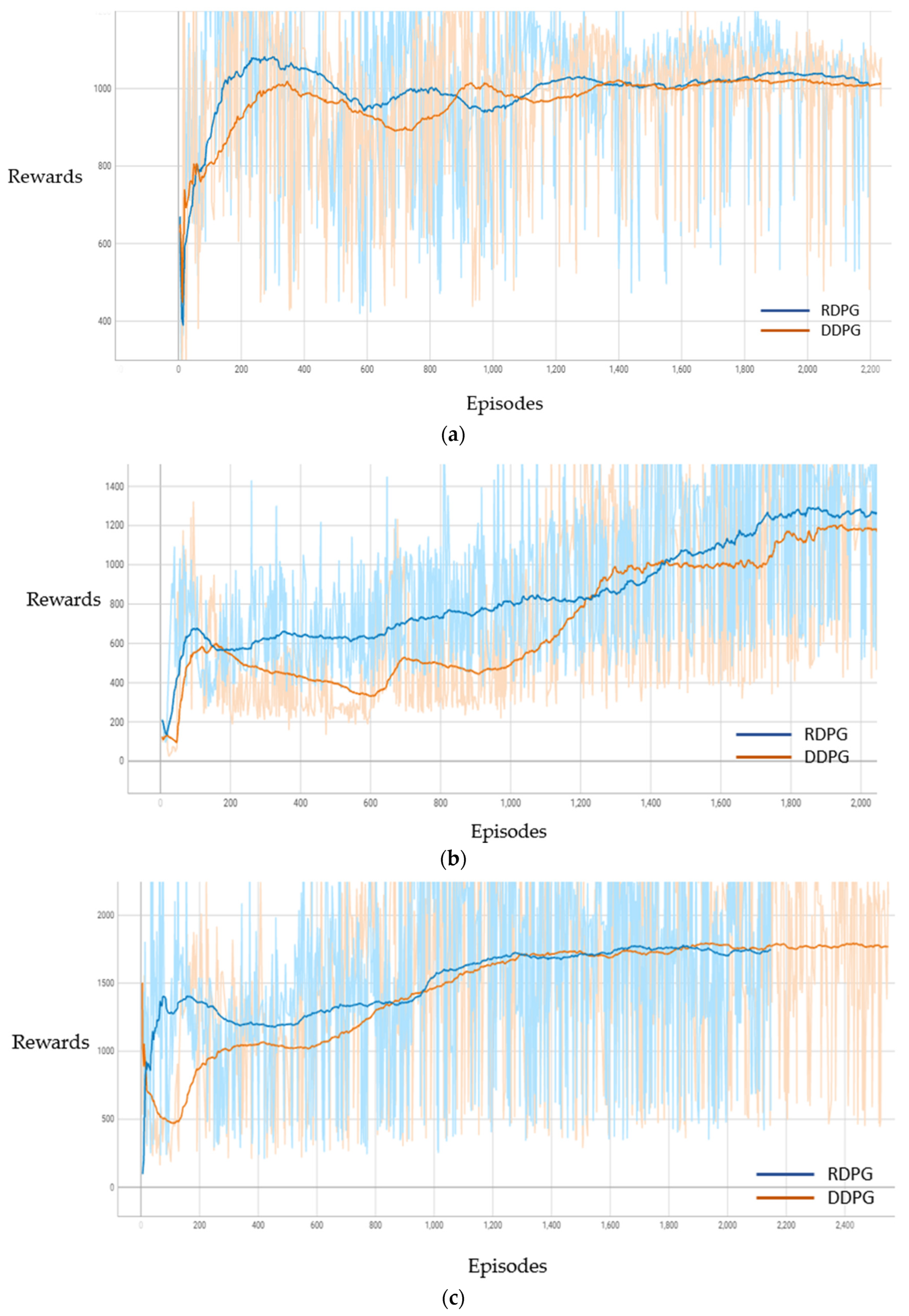

| The Parameter Name | Value |
|---|---|
| DDPG Replay Buffer Size | 16,000 |
| DDPG Batch Size | 150 |
| DDPG Replay Buffer training threshold | 500 |
| RDPG Replay Buffer Size | 6000 |
| RDPG Batch Size | 150 |
| DDPG Replay Buffer training threshold | 500 |
| The Parameter Name | Value |
|---|---|
| Learning rate α | Actor = 0.0001; Critic = 0.001 |
| Discount factor γ | 0.9 |
| Tau (τ) | 0.005 |
| OU Noise: | All = 0.35 |
| OU Noise: | Throttle = 0.1; Other = 0.2 |
| OU Noise: | Throttle = 0.2; Other = 0 |
| Epsilon (ε) start | 1 |
| Epsilon (ε) decay | 0.99 |
| Epsilon (ε) min | 0.01 |
Disclaimer/Publisher’s Note: The statements, opinions and data contained in all publications are solely those of the individual author(s) and contributor(s) and not of MDPI and/or the editor(s). MDPI and/or the editor(s) disclaim responsibility for any injury to people or property resulting from any ideas, methods, instructions or products referred to in the content. |
© 2024 by the authors. Licensee MDPI, Basel, Switzerland. This article is an open access article distributed under the terms and conditions of the Creative Commons Attribution (CC BY) license (https://creativecommons.org/licenses/by/4.0/).
Share and Cite
Tsai, J.; Chang, Y.-T.; Chen, Z.-Y.; You, Z. Autonomous Driving Control for Passing Unsignalized Intersections Using the Semantic Segmentation Technique. Electronics 2024, 13, 484. https://doi.org/10.3390/electronics13030484
Tsai J, Chang Y-T, Chen Z-Y, You Z. Autonomous Driving Control for Passing Unsignalized Intersections Using the Semantic Segmentation Technique. Electronics. 2024; 13(3):484. https://doi.org/10.3390/electronics13030484
Chicago/Turabian StyleTsai, Jichiang, Yuan-Tsun Chang, Zhi-Yuan Chen, and Zhehao You. 2024. "Autonomous Driving Control for Passing Unsignalized Intersections Using the Semantic Segmentation Technique" Electronics 13, no. 3: 484. https://doi.org/10.3390/electronics13030484
APA StyleTsai, J., Chang, Y.-T., Chen, Z.-Y., & You, Z. (2024). Autonomous Driving Control for Passing Unsignalized Intersections Using the Semantic Segmentation Technique. Electronics, 13(3), 484. https://doi.org/10.3390/electronics13030484




